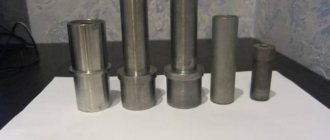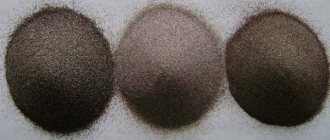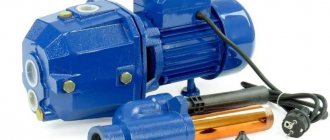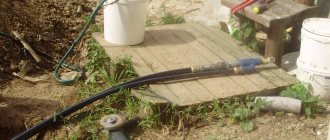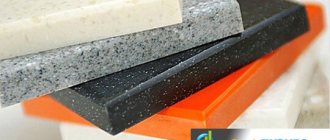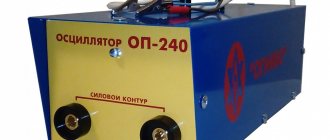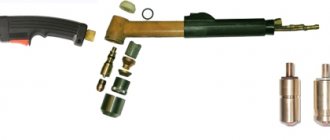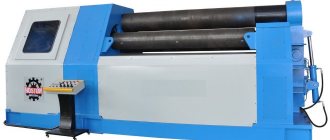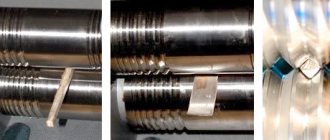The nozzle, which is used to equip a sandblasting machine, is the most important design element of such a device. Only a correctly selected nozzle will allow you to most effectively use the sandblaster for its intended purpose: to clean various surfaces from dirt, old coatings, traces of corrosion, degrease them and prepare them for further processing.
For each application, you can select a nozzle of a certain diameter, depending on the fraction of sand used
The tasks that a sandblasting nozzle solves are to compress and accelerate to the required speed a mixture consisting of air and abrasive material, as well as to form a working spot and saturate it with abrasive acting on the surface of the workpiece. Depending on the size of the surface to be sandblasted, different types of holes can be made in the nozzles. Thus, for processing narrow surfaces, nozzles with the same diameter along the entire length are used, and for cleaning large surfaces, products are used, the holes in which have larger diameters at the inlet and outlet (Venturi type, developed in the middle of the last century).
Compressor performance
The diameter of the nozzle, first of all, depends on the performance of the compressor (the number of cubic meters of compressed air per minute): the more productive the compressor, the larger the diameter of the nozzle can be used effectively (see table below). The most interesting thing: the higher the compressor performance, the less abrasive consumption will be for cleaning each square meter of the surface being treated.
If you use a nozzle that is less than optimal, there will be a loss of performance and the nozzle may become clogged more often.
If the nozzle is larger than optimal, there will be a loss of kinetic energy of the abrasive-air mixture, which also entails a drop in work productivity with a simultaneous overconsumption of abrasive material.
The pressure created by the compressor is not a determining factor and will be an important parameter if the work site is located far from the compressor, or is located much higher in level than the compressor.
What is a sandblasting nozzle?
The simplest design is a hollow tube, which has, on one side, a thread, which is necessary to connect the part to the nozzle holder. It is through this part that sand comes out, which is why it is subjected to increased mechanical stress.
Basic geometric characteristics of the element:
- Connecting thread section. The most common diameters are 2 and 1¼ inches. There are also connections where a union nut and a sealing washer are used. Homemade elements are usually connected using ordinary clamps.
- Length. It can vary from 7 to 23 mm.
- Minimum internal diameter. There are 6, 8, 10 and 12 mm.
- Entry diameter. It must match the size of the connecting hose.
The main parameter is the hole profile, that is, its shape. It determines the abrasive output speed and consumption. The profile is also responsible for hydraulic resistance, which affects service life.
Hydrosandblasting
Hydrosandblasting can be carried out regularly in a normal garage or on-site environment, also using regular PPE. The bodies of old cars, after cleaning with hydrosandblasting, are quite suitable for painting; distance of the site or workshop from the above objects - from 50 m. Hydrosand jet is used without a compressor from a portable car wash or household “sprinkler” for windows and display cases
Therefore, special attention should be paid to hydrosandblasting
The design diagram of a hydrosandblasting installation driven by a portable washing machine is shown on the left in the figure:
Diagram of a hydrosandblasting installation and a simple nozzle for hydrosandblasting
A drawing of a simple nozzle made from parts of a water supply system for hydrosandblasting is on the right; The inset shows its appearance. The operating principle is ejection. However, such a nozzle works with some washers, but not with others, and the limits for adjusting the jet density and abrasive flow rate with a suitable drive are insufficient. The reason is the oblique concentrated supply of the abrasive-air mixture to the ejector.
The nozzle with coaxial supply of water and abrasive-air mixture works stably with any car and household washing installations. For example, the nozzle, the drawings of which are shown in Fig., was originally developed for the Kärcher car wash. But it is also suitable for any other thread with a standard G1/4” tip. And if the standard fit is different, then it is enough to make a connecting socket for it (see item 1).
Drawings of a universal hydrosandblasting nozzle for portable washers
How to make a hydrosandblasting nozzle for a portable car wash, see also the video:
Choosing the right nozzle: compressor installation parameters
An important factor for obtaining high productivity of the cleaning process is the accurate selection of the required nozzle diameter for the compressor used.
For this, the following parameters are defined:
- pressure of the compressor used (bar);
- total capacity of the compressor unit (m3/min).
Quite often, technical indicators cannot be achieved due to wear of the internal screw pair of the compressor equipment used. According to the parameters, the compressor should provide approximately 50% more of a certain volume of air flow than required by the new nozzle being used.
Thanks to the existing performance reserve, the high efficiency of the cleaning performed is maintained in the event of partial wear of the installed nozzle. To prevent this phenomenon, the element is replaced when the diameter increases by approximately 30%, despite the sufficient thickness of the walls of the stakes.
For example, an increase in the diameter of the working nozzle from 8 to 11 mm has a significant impact on the performance of the cleaning performed. In this case, the inlet neck of the structure must be the same as the inner diameter of the hose through which the abrasive and air flow are supplied. If the combination of parameters is incorrect, wear points appear, pressure drops and severe turbulence occurs inside.
Types of structures
Types of sandblasting units vary depending on the task at hand. If you need to decoratively process glass, it is advisable to use a sandblasting chamber. To clean parts, an open type device is used. An open type sandblasting machine (depending on how the abrasive is supplied) is divided into several types:
- pressure;
- injection.
The pressure apparatus supplies air inside the unit, as well as into the dispenser of the sand container. The air flow will move, and then the compressed gas will enter the hose with a nozzle. The nozzle will determine the shape, as well as the pressure of the jet. This type of machine is usually used to process large surfaces and can be used for many hours.
The injection apparatus differs in that sand and air will move through different hoses. As a result, a small pressure will be created, which is suitable for short-term work.
How to make it yourself?
The service life of a homemade nozzle is short, but its cost will be minimal. To make the part, a car spark plug or an old ceramic resistor is suitable. The internal diameter should be 2-4 mm.
To make a nozzle from a resistor, you need:
- Cut off the caps and stems.
- Take an M14 bolt. It is necessary to cut off the top, and then drill the hole through with a No. 5 drill.
- Extend the first 14 mm with a No. 8 drill.
- A wide M5 washer is welded onto the clamping nut.
- Using a No. 8 drill, a cone is made.
To make a spark plug you need:
- Remove the contact plug. To do this, it is better to first warm the candle with a gas burner.
- Remove the rolled part.
- Remove the ceramic insulator.
- Remove the nut. It's better to cut its edges first.
- Using a grinder with a diamond blade, cut off the part where the central electrode is located.
- Connect the adapter with the clamping nut. You need to buy it or grind it yourself in advance.
If sandblasting is used regularly, it is better to buy a ready-made high-quality part. There are various nozzles on sale with high performance and long service life.
Operating principles
A lot depends on the nozzle: the quality and the processing process itself, the consumption of air and sand. This element can be made of different materials, which affects its durability. Cheap elements are designed to last several tens of hours, but it happens that they are destroyed after just an hour of operation. This applies to ceramic and cast iron parts. Tungsten carbide nozzles can last up to 1000 hours of operation. But they are relatively expensive.
Recommendations from experts
Most of the problems that arise are related to improper assembly of the installation. Experienced craftsmen advise including air recirculation devices in the system, which seriously increases the productivity of sandblasting. Also, the quality of the finished device will be improved by a correctly selected nozzle. Tungsten nozzles are ideal because they have a long service life.
As for the compressor, you can take any device lying around in the garage, but more powerful units will increase efficiency. A homemade compressor will save money and make various jobs easy and affordable, reducing time costs.
Peculiarities
A sandblasting machine is a long-time and successfully used device that is used to clean surfaces from dirt. Its main purpose is to create a powerful supply of abrasive mixture. The simplest nozzle holder can be made with your own hands at home, but modern designs not only form a torch (a directed jet of air and sand), but also prepare it, use it economically, and impart the characteristics necessary for a specific surface.
Such devices can be used in a variety of situations - from cleaning the walls of houses to removing rust from a metal surface, and even for engraving on a glass surface. Hence the variety of models, simple, but made in different sizes. The need to work with a certain material and create the proper pressure dictates the requirements for the dimensions of the apparatus and its components. One of them is a sandblasting nozzle.
The importance of this detail is difficult to overestimate, since it is it that increases the flow rate of the mixture from the unit and forms a torch . It is selected according to its intended purpose and performance characteristics, as well as the nozzle holder, which is sometimes considered by craftsmen to be part of the functional bell.
Despite the similarity of the design (consists of a body, threads for reliable fastening, confuser and diffuser), it is divided into different types according to:
- the material of the case (its strength and service life depend on this) and the method of fixation to the handle - a nut or clamp;
- the diameter of the holes in the confuser (selected according to the sandblasting performance indicator);
- diffuser expansion angle;
- the shape of the outlet (round or oval, determined by the shape and size of the object being cleaned).
Standing apart from the simple lineup is the Venturi nozzle . It cannot be done at home, since this will not allow for a stepwise change in the cross-section.
An important difference that deserves close attention when choosing is the material of manufacture. Knowing some features, you can choose a nozzle that is suitable for achieving your goal and will last a longer time.
